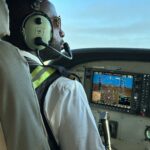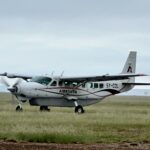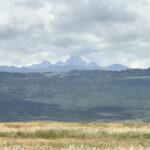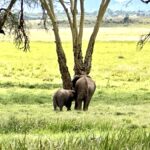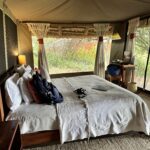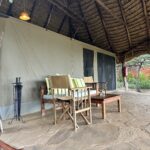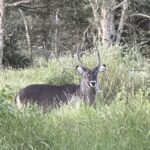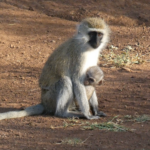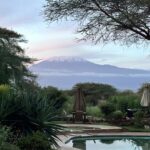
http://smragan.com/2010/11/ Breakfast with a view of Mt Kilimanjaro and the pool
Piracanjuba We grabbed an early breakfast at Tawi, climbed aboard George’s trusty LandCruiser to set off for Amboseli airport – I spelled it with a little a not a capital A since it was hardly more than a landing strip. We bid goodbye to George, who we’ll see again Tuesday morning.
Our pilot, Seth, diverted us further south to pick up three additional passengers, who almost missed the flight, scheduled to leave at 8:45 am, and they showed up at 8:43 am with rolling bags! Smart travelers we are with soft-sided hand carried bags (1 per person). This landing strip was more basic than the one at Amboseli – it wasn’t even paved! Later, back at home, we found out that one of the men was a professional photographer from Williamsburg, VA and that my friend had gone to a photo safari he gave at the Williamsburg Library! This trip he was looking for a cat he hadn’t been able to see on his earlier trips! Small World!
It was a short 50 minute flight to Wilson Airport in Nairobi, where we hopped an AirKenya flight to Lewa Downs, in the central highlands. IYKYK, the area was also home to Happy Valley, a hedonist community of aristocrats, farmers and socialites whose promiscuous lifestyle was centered in the area in the 1930’s.
We were met by Abdul, our guide for our game drives here in the Lewa Conservancy. He came equipped with water and other drinks for our ride to the lodge. Lewa was established as a cattle ranch in the 1920’s. A portion was set aside as a wildlife sanctuary in 1983, the remainder (102 square miles) followed 10 years later, the Lewa Conservancy.
We caught a glimpse of Mount Kenya, the second highest peak in Africa.
The grass here is higher and greener than normal due to the recent rains. It appears that the grass is as high as the sides of our vehicle. The driver sits lower than the passengers, each row of passengers sits higher than the row in front to ensure the best visibility for all.
After we passed a baby elephant nursing, we caught a glimpse of zebra. One of whom was the endangered Grevy’s Zebra.There are only about 380 individual Grevy’s zebra here which is about 20% of the world population.
We also passed an area known as Acheulean Hand-Axe site, where hand tools made from volcanic rocks have been found dating to 800,000 years ago.
We finally arrived at the Lewa Safari Camp and explored our accommodations for the next three nights. We have a beautiful veranda overlooking the valley in front of essentially a permanent tent structure with a bedroom and bathroom. The lodge itself has a pool, a lunch veranda, a dining room for dinner, and a gathering center, with administrative area, spa, and gift shop.
We had a delicious lunch by the pool and settled into our lodging. Plans were made to assemble for afternoon tea and a late afternoon game drive with Abdul before dinner
Afternoon Game Drive Saturday
We set out on a game drive with Abdul about 4pm over roads that were merely wheel ruts through the conservancy. The terrain here is different than Amboseli with rolling hills, marshes, swamps, and watering holes spread out throughout the area.
We were very fortunate to encounter many zebra, both the Grevy’s Zebra with a white belly, narrower stripes, and round bear-like ears. The ones we saw this afternoon appeared to be in herds that mixed the plains zebra with the Grevy’s zebra — and also some hybrids. The Zebras stripes are as individually unique as fingerprints. Zebras are in the same genus as their domesticated counterparts, resembling a striped hybrid between a horse and an ass. The most common is the Plains Zebra, a grazer, often seen in large herds, but its core social unit is an aggressively defended non-territorial herd made up of one stallion, up to five mares, and their respective foals.The striping is not camouflage, since they inhabit arid areas. More likely, it is to confuse predators when they scatter. Grevy’s Zebra is the world’s largest equid, standing up to 5 feet at the shoulder and weighing up to almost 950 pounds. Grevy’s move in smaller herds than plains zebras and a stallion enjoys exclusive mating rights with any female passing through its territory.
We found a Waterbuck, a large member of the Kob family and is recognized by its shaggy gray brown to chestnut coat. The males have a large, lyre shaped horns, and have bold white rump markings. It is usually found in standing water or marshes with herds of up to 10 individuals overseen by one aggressive, dominant male. The waterbuck of the Rift Valley is more chestnut and has a full white rump, while the eastern variety has a white U on its rump.
We found a group of Vervet monkeys playing in trees along the edge of the road. They are generally mischievous and viewed as one of the true characters of the African savannah. It can live in troops of 30 to 75 animals that are constantly engaging in entertaining interaction, whether fighting, grooming, carrying young on their chest, clambering around branches, or raiding lunch buffets. It is thought to be the most numerous primate species (apart from humans) and is mainly terrestrial, although it rarely strays far from trees. It is smaller and lankier than a baboon, with a light-olive or grey coat offset by a black face, white ruff and pale belly. Males have gaudy blue scrotum offsetting this dull coloration. It is highly intelligent, has quite an array of alarm calls that scientists have likened to rudimentary language.
We got up close and personal with White Rhinoceros. They are bulkier than Black Rhinos, and are the world’s heaviest non-marine mammal after the elephant weighing up to almost 8,000 lbs. Misleadingly named, it has smooth grey skin – the misnomer “white” comes from the Dutch word weit (wide) and refers to the square lips it uses to crop grass. The White Rhino was once found throughout Africa, but hunting brought them to almost extinction. The Rhino now is found on preserves, sanctuaries, conservancies and parks. The White Rhino has a bit of a bump on its back to differentiate it from the Black Rhino. In many photos of them you will see cattle birds riding on them, picking off ticks, etc.
We saw other wildlife and birds and even a rainbow! We returned our lodge and tents shortly after dark, close to 7:20 PM. Freshened up a bit, then enjoyed another delicious dinner!

